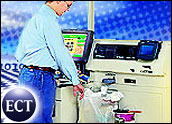
It’s not easy to find something to like about air travel these days — the industry, after all, has the lowest customer satisfaction ratings in the economy — but Gail Bower, president of Bower & Co. Consulting, has: the self-service kiosks that just about every airline now uses to handle automated tasks.
They are easy to use and they keep the lines down to a minimum, she commented. And they are smart — a trait Bower experienced firsthand on a recent trip to Florida. “I had to catch a connection to get to my destination, and the airline’s kiosk only printed out one boarding pass,” she told CRM Buyer.
She thought it had made a mistake and was resigning herself to a wait in line and possible complications at the desk. “Then one of the attendants told me that the boarding pass was good for both flights — that the kiosk automatically booked me through.”
For Bower — and indeed, most of us who use these kiosks in airports, hotels, grocery stores and retail chains — this incident illustrates the reasons why we both love and hate self-service kiosks: When they work as planned, they are a happy convenience. When they don’t work, they become the focal point for all that is wrong with customer service.
$1.7 Trillion and Counting
For those who bemoan the growing ubiquity of self-service kiosks, now is the time to brace yourself. The number of transactions service providers will shunt through these systems will triple in the next four years. Transactions at self-service kiosks will surpass US$607 billion this year in North America, according to a recently released study by the IHL Group. By 2012, that number will have reached more than $1.7 trillion.
Much of this trend is fueled by service providers who like the cost-benefit ratio of installing a kiosk, Greg Buzek, president of the IHL Group, told CRM Buyer. However, besides dollar savings, he says, these companies also insist they deliver customer satisfaction gains.
He points to another IHL study as illustration; it showed that airlines such as Southwest, Northwest and Delta claim that as much as 70 percent of all passengers prefer to use these kiosks for check-in.
Other studies back up these claims. Last year, for instance, a study conducted by BuzzBack Market Research for NCR found that more than three out of four (77 percent) of the U.S. and Canadian consumers polled said they are more likely to do business with organizations that offer self-service, and 92 percent value combining mobile devices with the Internet and self-service kiosks or ATMs to improve their overall service experience.
Besides airline check-in, consumers would like to see automated multipurpose kiosks that let them renew drivers’ licenses or vehicle registration (76 percent); checking the status of items ordered online (71 percent); purchasing transit or airline tickets (62 percent); making photocopies (57 percent); and ordering flowers, books and other items (54 percent).
Mixed Emotions
However, even consumers that happily use self-service kiosks to bypass lines have mixed emotions about them; their love of the convenience is tempered with what kiosks represent in customer service and even employment trends. Some people surveyed by IHL refuse to use them because they represent lost jobs, Buzek said.
More people focus on the missing human touch in transactions though. “When we used to have higher standards of customer service, that human interaction shaped the repute of a business,” Bower said. “Now that piece is diminishing.”
When Bower has a complication or a change to her travel plans, “then kiosks are useless and frustrating.” Indeed, when the kiosk spit out her sole boarding pass, it could have wound up causing her more trouble than it was worth — except for the nearby attendant who explained the situation to her.
“Companies that use kiosks to completely eliminate front-line service people are making a big mistake,” she said.
Delays and Breakdowns
A lot depends on what tasks the kiosks are replacing, said Mellanie True Hills, CEO of StopAfib.org, and author of the book, A Woman’s Guide to Saving Her Own Life.
“The self-service kiosks [in] stores like Wal-Mart and the bigger grocery stores are terrible — they cannot handle such a diversity of products and they become either too slow or there are too many rejects that then require a clerk,” she told CRM Buyer.
Some transactions just call out for a human clerk too. “When I buy beer or wine, the kiosk stops so a clerk can card you,” — hardly something that would happen to the 50-something-year-old True Hills if she had gone through the regular checkout, she noted. The worst situation, though, is when the machine stops working in mid-transaction and the consumer has to start all over again.
Breakdowns are one of the chief complaints people have against self-service kiosks, according to IHL’s figures.
It happens, Amanda Verrie, president of RealTime Shredding, which manufactures and markets the Self-Service Shredder, a self-service shredding kiosk designed specifically for business and consumer use, told CRM Buyer.
“No matter how often and well you service a kiosk, it will sometimes be down,” she said. “Even if there is a number to call posted clearly on the kiosk, it represents another step the consumer must take.” However, she promised, as self-service kiosks continue to improve, downtime will become even more minuscule.






















































Self-service can clearly generate a big payoff. Yet, a recent study our team did shows that SS adoption is actually reaching a plateau. Why? Certainly there are still technical limitations and companies rarely *really* listen to user needs. But more importantly, there needs to be an easy way to get live assistance, whether in person, on the phone or online.